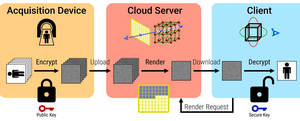Information
- Publication Type: Journal Paper with Conference Talk
- Workgroup(s)/Project(s):
- Date: October 2020
- Journal: IEEE Transactions on Visualization andComputer Graphics
- Volume: 27
- Open Access: yes
- Lecturer: Sebastian Mazza
- Event: IEEE VIS (SciVis) 2020 conference
- DOI: 10.1109/TVCG.2020.3030436
- Call for Papers: Call for Paper
- Conference date: 10. January 2020 – 13. October 2020
- Pages: 1 – 10
- Keywords: Volume Rendering, Transfer Function, Homomorphic-Encryption, Paillier
Abstract
Computationally demanding tasks are typically calculated in dedicated data centers, and real-time visualizations also follow this trend. Some rendering tasks, however, require the highest level of confidentiality so that no other party, besides the owner, can read or see the sensitive data. Here we present a direct volume rendering approach that performs volume rendering directly on encrypted volume data by using the homomorphic Paillier encryption algorithm. This approach ensures that the volume data by using the homomorphic Paillier encryption algorithm. This approach ensures that the volume data and rendered image are uninterpretable to the rendering server. Our volume rendering pipeline introduces novel approaches for encrypted-data compositing, interpolation, and opacity modulation, as well as simple transfer function design, where each of these routines maintains the highest level of privacy. We present performance and memory overhead analysis that is associated with our privacy-preserving scheme. Our approach is open and secure by design, as opposed to secure through obscurity. Owners of the data only have to keep their secure key confidential to guarantee the privacy of their volume data and the rendered images. Our work is, to our knowledge, the first privacy-preserving remote volume-rendering approach that does not require that any server involved be trustworthy; even in cases when the server is compromised, no sensitive data will be leaked to a foreign party.Additional Files and Images
Weblinks
BibTeX
@article{Mazza_2020,
title = "Homomorphic-Encrypted Volume Rendering",
author = "Sebastian Mazza and Daniel Patel and Ivan Viola",
year = "2020",
abstract = "Computationally demanding tasks are typically calculated in
dedicated data centers, and real-time visualizations also
follow this trend. Some rendering tasks, however, require
the highest level of confidentiality so that no other party,
besides the owner, can read or see the sensitive data. Here
we present a direct volume rendering approach that performs
volume rendering directly on encrypted volume data by using
the homomorphic Paillier encryption algorithm. This approach
ensures that the volume data by using the homomorphic
Paillier encryption algorithm. This approach ensures that
the volume data and rendered image are uninterpretable to
the rendering server. Our volume rendering pipeline
introduces novel approaches for encrypted-data compositing,
interpolation, and opacity modulation, as well as simple
transfer function design, where each of these routines
maintains the highest level of privacy. We present
performance and memory overhead analysis that is associated
with our privacy-preserving scheme. Our approach is open and
secure by design, as opposed to secure through obscurity.
Owners of the data only have to keep their secure key
confidential to guarantee the privacy of their volume data
and the rendered images. Our work is, to our knowledge, the
first privacy-preserving remote volume-rendering approach
that does not require that any server involved be
trustworthy; even in cases when the server is compromised,
no sensitive data will be leaked to a foreign party.",
month = oct,
journal = "IEEE Transactions on Visualization andComputer Graphics",
volume = "27",
doi = "10.1109/TVCG.2020.3030436",
pages = "1--10",
keywords = "Volume Rendering, Transfer Function, Homomorphic-Encryption,
Paillier",
URL = "https://www.cg.tuwien.ac.at/research/publications/2020/Mazza_2020/",
}


 image
image Paper
Paper
